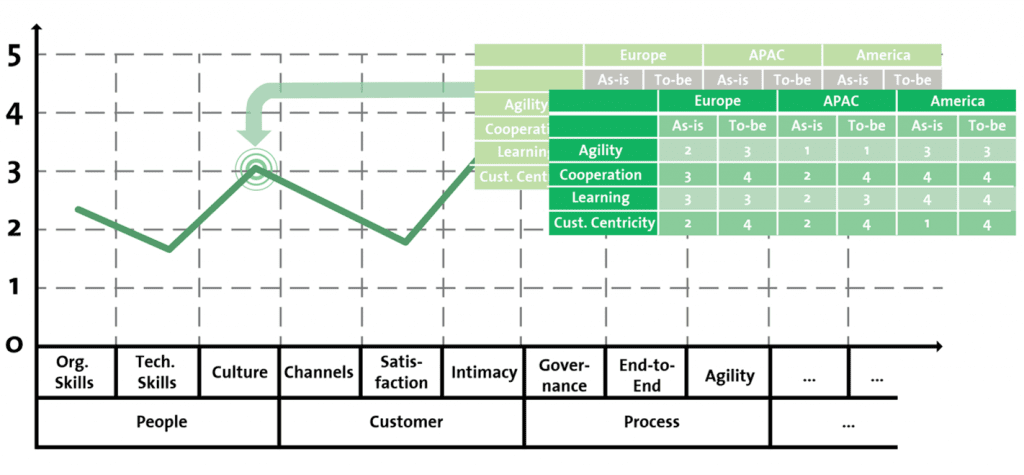As we have seen in the previous sections, digitalisation predominantly entails (a) transforming an enterprise’s portfolio of products and services and (b) acquiring capabilities the organisation requires to achieve the desired target state. Here, the Digital Matrix is a central steering tool which enables the successive development of corporate capabilities, leading to a targeted and well-structured transformation process. Different digitalisation dimensions have to be considered in order to specify and visualise the necessary change.
The Digital Matrix provides a hierarchical breakdown of the required capabilities of the organisation and compares the existing maturity of the digitalisation initiative with the target state.
Thus, it allows the CDO Office to keep track of the transformation process of the whole organisation. The Digital Matrix must be effective in at least two aspects. First, the Digital Matrix must provide a ‘big picture’ that is discussed at board level and serves as a ‘digitalisation dashboard’ of the whole enterprise. At that level, the matrix allows cross-cutting topics to be tackled, such as corporate culture or global training programmes. Second, in order to steer change at the level of business units with specific contexts, submatrices are needed and provide a more fine-grained view. It is important to note that there is no universal matrix; the dimensions needed vary from industry to industry and are unique for each enterprise. It is, therefore, up to each enterprise to set up its own Digital Matrices.
A digital assessment of the company must be undertaken to determine specific digitalisation dimensions and maturity levels. Here, internal and external factors have to be taken into consideration. First, market and trend analyses should take place.
The digitalisation requirements of the company are investigated based on critical success factors. In this context, a benchmark analysis is also recommended, since it will make the current market position transparent with respect to competitors. One possible approach is to base the market analysis on the Five Forces Model by Porter.[1] In this model, the following aspects are evaluated: (1) the threat of new entrants, (2) the bargaining power of suppliers, (3) the threat of substitutes, (4) industry rivalry and (5) the bargaining power of buyers. One result could be the need for a fundamental change in the business portfolio (i.e., of the existing business model and business strategy), in the course of which new digital capabilities are developed.
In addition to the external analysis, an in-depth evaluation of the internal digitalisation status with regard to technical (IT) and business capabilities must take place (for example, ‘the interoperability of IT systems’ or ‘the ability to change’). If a digital readiness assessment has already been conducted, this can be used as a valuable underlying base.
Finally, the enterprise must determine its critical success factors and its own digitalisation dimensions and maturity levels. This is important because different industries and market conditions typically result in different success factors. The various digitalisation dimensions can be deduced from the following clusters:
Since data has become a key asset (e.g., in the form of an API or integrated products) and customer centricity is one of the driving forces of digitalisation as a whole, the Data and Customer clusters are two especially central pieces of the transformation process.
When defining maturity levels, frameworks such as COBIT or CMMI can be used as references. It is important to refine the maturity levels of each dimension by defining specific action plans or checklists, including required deliverables. This has to be done for the ‘big-picture’ matrix as well as all submatrices. It then becomes possible to visualise the whole digitalisation initiative in a quantitative and qualitative way, as well as identifying the current and target states.
This ensures that all stakeholders have a clear understanding of when a maturity level is reached in any given dimension that affects them. The example shows a submatrix depicting the distribution of organisational and technical skills across the value chain of the enterprise.
It is important to note that the concept of the Digital Matrix must be integrated into existing corporate processes. This can be based on the documented results from the internal and external assessments. The ‘big-picture’ matrix should be located in a prominent strategic place – e.g., the digital headquarters – from where the digitalisation initiative can be steered. There, it can be used as a transformation dashboard in the day-to-day work of the CDO or an equivalent governance body.
The integration of the digital matrices into the project portfolio management process is also key, since the transformation of the company is driven by concrete projects.
In this respect, the matrices become an integral part of the roadmap planning. ‘White spots’ can be identified early on and new projects can be initiated accordingly. In addition, governance structures, e.g., a digitalisation board, and defined KPIs ought to be established.
This enables senior management to make the right direct strategic investment decisions with respect to the modernisation of the business portfolio, which in turn leads to an efficient management of the digitalisation initiative.
_____
[1] Porter, M. E.: ‘Competitive Strategy: Techniques for Analyzing Industries and Competitors’, Free Press, 1998.




